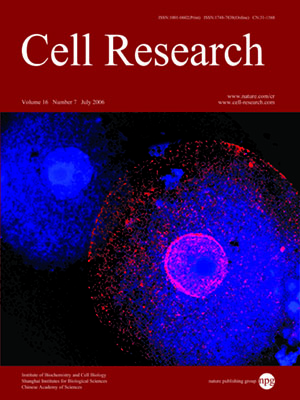
Volume 16, No 7, Jul 2006
ISSN: 1001-0602
EISSN: 1748-7838 2018
impact factor 17.848*
(Clarivate Analytics, 2019)
Volume 16 Issue 7, July 2006: 622-631
ORIGINAL ARTICLES
Inhibition of the α-mannosidase Man2c1 gene expression enhances adhesion of Jurkat cells
Li Qu,Ji Yu Ju,Shuang Ling Chen, Yan Shi, Zhi Guang Xiang, Yi Qun Zhou, Yun Tian, Yin Liu,Li Ping Zhu
1Department of Immunology, Institute of Basic Medical Sciences, Chinese Academy of Medical Sciences and Peking Union Medical College, Beijing 100005, China
Correspondence: Li Ping Zhu(zhulp@pumc.edu.cn)
Protein N-glycosylation plays very important roles in immunity and α-mannosidase is one of the key enzymes in Nglycosylation.
This paper reports that inhibition of α-mannosidase Man2c1 gene expression enhances adhesion of Jurkat
T cells. In comparison to the controls with normal expression of the enzyme, Jurkat cells with the inhibition of Man2c1
gene expression (AS cell) formed larger aggregates in culture, indicating an enhancement of adhesion between the cells.
mRNA differential display analysis discovered up-regulation of several adhesion molecule genes in the AS cell. Because
of the pivotal role played by CD54-LFA-1 interaction in immune cell interaction, this study focused on the contribution
of enhanced expression of CD54 and LFA-1 to the enhanced adhesion of AS Jurkat cells. These facts, including increased
binding of AS cells to ICAM-1-Fc, Mg2+ activation of the binding of AS cells to ICAM-1-Fc and enhanced aggregation
of AS cells, together with the inhibiting effect of a blocking CD11a mAb on the binding to ICAM-1-Fc and aggregation
of the cells demonstrate an important contribution of enhanced CD54-LFA-1 interaction to increased adhesion between
AS cells. The enhanced CD54-LFA-1 interaction also resulted in increased adhesion between AS Jurkat T cells and Raji
B cells. In addition, AS cells showed cytoskeletal rearrangement. The data imply a biological significance of MAN2C1
in T-cell functioning.
Cell Research advance online publication 23 May 2006; doi: 10.1038/sj.cr.7310065
FULL TEXT | PDF
Browse 2160


